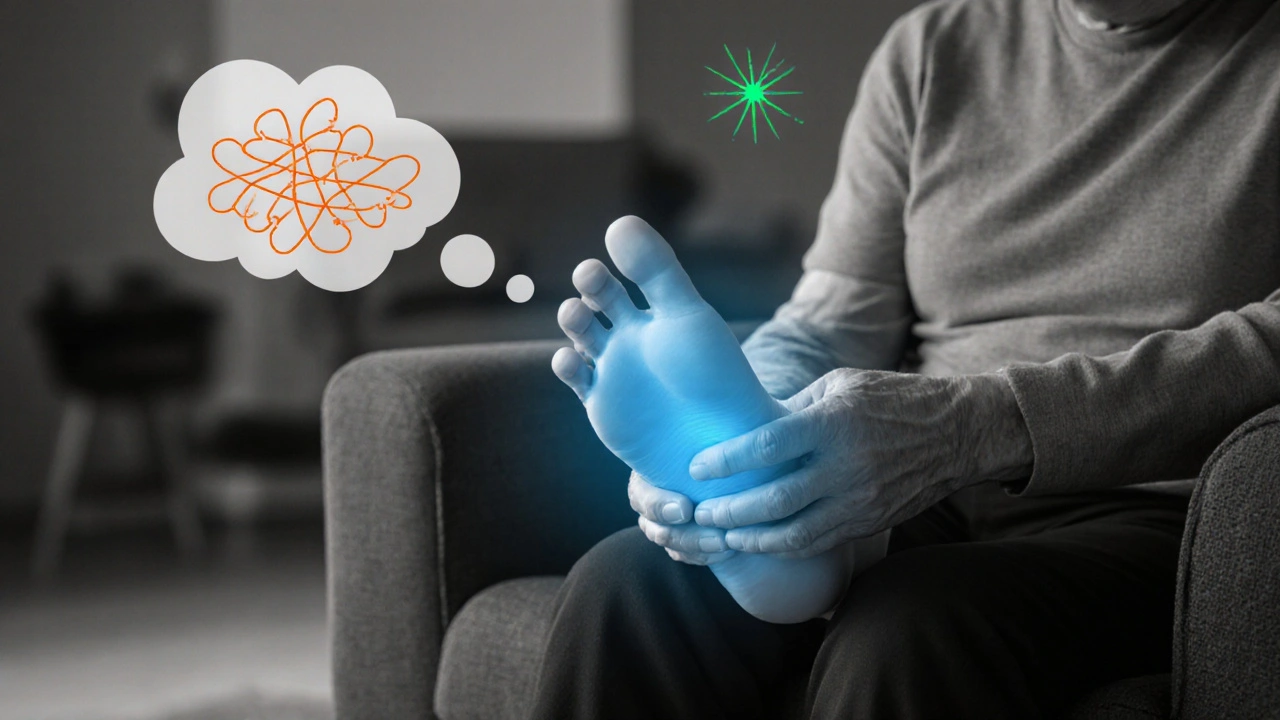Gout Symptom & Mindset Tracker
Daily Tracking Log
Your Insights
Today's Mental State Score
Recommended Next Step
Key Insight
Living with gouty arthritis isn’t just a battle against joint pain - it’s a constant mental tug‑of‑war. One minute you’re managing a flare, the next you’re worrying whether the next attack will knock you out of work or family plans. The good news? Your mindset can tip the scales. By learning to think positively, you can lower stress hormones, improve pain tolerance, and keep the condition from hijacking your life.
What Exactly Is Gouty Arthritis?
Gouty Arthritis is a form of inflammatory arthritis caused by the crystallisation of uric acid in joints. When the body produces too much uric acid or fails to excrete it efficiently, sharp needle‑like crystals form, most often in the big toe, ankle, or knee. The sudden inflammation triggers intense burning pain, redness, and swelling that can last from a few days to a couple of weeks.
Typical triggers include high‑purine foods (red meat, seafood), alcohol, dehydration, and certain medications. Over time, repeated attacks can damage cartilage, leading to chronic joint pain and reduced mobility.
Why Mindset Matters in Pain Management
Think of your brain as a thermostat for pain. When you’re stressed or anxious, your body releases cortisol and adrenaline, which amplify inflammation and heighten pain signals. Conversely, a relaxed, optimistic mindset can trigger the release of endorphins - natural painkillers that dampen the sensation of hurt.
Research from the University of Michigan (2023) showed that patients who practiced daily gratitude exercises reported a 30% reduction in flare‑up frequency compared with a control group. The mental shift didn’t cure the disease, but it lowered the physiological stress response that often fuels attacks.
Common Mental Hurdles for Gout Sufferers
- Fear of the next flare: Constantly worrying about when pain will strike can create a self‑fulfilling prophecy, increasing muscle tension and inflammation.
- Helplessness: Feeling that diet and medication are the only levers you can pull makes it hard to stay motivated.
- Isolation: Flare‑ups often force you to miss social events, which can spiral into loneliness and depression.
- Negative self‑talk: Thoughts like “I’ll never be normal again” erode confidence and amplify stress hormones.

Positive‑Thinking Strategies That Really Work
Below are three evidence‑based techniques you can start using today. Each method targets a different mental hurdle while also influencing physiological pathways linked to gout.
| Technique | Key Mental Benefit | Physical Impact on Gout |
|---|---|---|
| Gratitude Journaling (5 min/day) | Shifts focus from pain to appreciation, reducing rumination | Lowers cortisol, may decrease flare frequency |
| Cognitive‑Behavioral Therapy (CBT) Sessions | Reframes catastrophic thoughts, builds coping skills | Improves pain tolerance, reduces stress‑induced inflammation |
| Mindful Breathing (3‑5 breaths/min, 5min) | Calms nervous system, lessens anxiety spikes | Activates parasympathetic response, aiding uric‑acid clearance |
Pick the one that feels most doable, try it for two weeks, and track any changes in pain intensity or flare frequency.
Lifestyle Tweaks That Reinforce a Positive Mindset
Positive thinking isn’t a magic spell; it works best when paired with concrete lifestyle actions that support both mental and physical health.
- Exercise Regularly: Low‑impact activities like walking, swimming, or yoga improve circulation, help maintain healthy uric‑acid levels, and release endorphins that boost mood.
- Stay Hydrated: Aim for at least 2‑3liters of water daily. Proper hydration dilutes uric acid, making crystal formation less likely.
- Adjust Your Diet: Swap high‑purine foods for low‑purine alternatives (berries, cherries, low‑fat dairy). Cherries, in particular, contain anthocyanins that may reduce inflammation.
- Social Support: Share your goals with friends or join an online gout community. Knowing others understand your struggle reduces feelings of isolation.
- Sleep Hygiene: Aim for 7‑9 hours of quality sleep. Sleep deprivation spikes cortisol, which can trigger flares.

Real‑Life Success Stories
Maria, 48, diagnosed two years ago: “I used to dread every dinner because I’d end up with a painful toe. After I started a gratitude journal and cut soda, my flares dropped from six a year to one. I still have gout, but I feel in control.”
James, 62, long‑time gout sufferer: “CBT helped me stop thinking ‘I’m doomed to live in pain.’ I learned to challenge that thought, schedule short walks after meals, and my doctor noticed my uric‑acid levels fell without changing medication.”
Quick Checklist: Turning Thoughts into Action
- Write three things you’re grateful for each morning.
- Set a 5‑minute mindful breathing alarm on your phone.
- Schedule two low‑impact exercise sessions per week.
- Replace one high‑purine meal with a cherry‑rich fruit salad.
- Connect with a friend or online group at least once a week.
- Track pain levels in a journal; note any mental‑state correlation.
Review the list monthly and adjust as needed. Small wins add up, and over time you’ll notice both mood lifts and fewer flare‑ups.
Frequently Asked Questions
Can positive thinking replace medication for gout?
No. Mindset tools complement, but do not replace, prescribed urate‑lowering drugs. They can reduce flare frequency and improve quality of life, but you should always follow your doctor’s treatment plan.
How long does it take to see mental‑health benefits?
Most people notice a mood lift within two weeks of consistent practice, but noticeable changes in flare patterns may take a month or more.
Is mindfulness safe for everyone with gout?
Yes. Mindful breathing and short meditation have no physical side‑effects and can be adapted for any mobility level.
Do cherries really help?
Studies show that daily cherry consumption can lower serum uric‑acid levels by about 0.5mg/dL and reduce flare risk by roughly 35%.
What if I can’t find a therapist for CBT?
Many reputable apps (e.g., MoodGym, Woebot) offer CBT‑based modules at low cost. Look for programs that focus on pain coping and chronic illness.


Comments
Gena Thornton
A daily gratitude list can quietly shift the brain’s pain thermostat.
October 16, 2025 AT 18:13
Lynnett Winget
Imagine your mind as a garden; each grateful thought is a seed that crowds out the weeds of worry. Planting three simple thank‑yous each morning floods the brain with dopamine, which quietly dampens the pain spikes that gout loves to exploit. Swap the usual “ugh, another flare” narrative for a vivid picture of a future where you can stroll through a park without flinching. This shift doesn’t erase the uric crystals, but it rewires the stress‑response circuitry, making inflammation less eager to hit the stage. Pair the mental rehearsal with a glass of water and a brief stand‑up stretch, and you’ll notice the mental fog lifting faster than you’d expect. Keep the language bright-talk to yourself the way you’d pep‑talk a teammate before a big game. Consistency beats intensity; five minutes a day, day in and day out, is the secret sauce.
October 26, 2025 AT 00:26
Amy Hamilton
Positive thinking is not a mystical cure; it is a neuro‑chemical catalyst that can modulate the very pathways that convey gout pain. When you deliberately focus on appreciation, the limbic system releases endorphins, which act as natural analgesics, lowering the perceived intensity of a flare. Moreover, gratitude reduces cortisol, a hormone that otherwise fuels inflammation and encourages the crystallisation of uric acid in joints. The University of Michigan study cited in the article demonstrated a statistically significant 30 % drop in flare frequency among participants who practiced daily gratitude, underscoring the empirical foundation of this approach. In practice, writing down three things you are thankful for each morning creates a habit loop that trains the brain to anticipate reward rather than threat. This anticipatory reward state can be reinforced by complementary actions such as a brief mindfulness breathing session, which further activates the parasympathetic nervous system. The parasympathetic response aids kidney function, enhancing the excretion of excess uric acid and thereby reducing the substrate for crystal formation. While the mind cannot dissolve existing crystals, it can attenuate the cascade of stress hormones that amplify the inflammatory response each time a crystal deposits. Therefore, a disciplined mental routine works synergistically with pharmacological urate‑lowering therapy, not in opposition to it. It is also worth noting that the mental shift can improve adherence to dietary recommendations, as a positive outlook reduces the feeling of deprivation associated with cutting high‑purine foods. Over time, this dual benefit-lowered physiological stress and better lifestyle compliance-creates a virtuous cycle that sustains joint health. Importantly, the benefits are cumulative; research suggests that noticeable reductions in flare frequency may emerge after four to six weeks of consistent practice. Patients who report feeling “in control” often describe a newfound confidence to engage in low‑impact exercise, which further promotes circulation and uric acid clearance. The psychological empowerment derived from these techniques also combats the isolation that many gout sufferers experience, fostering social interaction that itself can boost mood‑enhancing neurotransmitters. In sum, the evidence points to a compelling case for integrating gratitude journaling, mindful breathing, and cognitive reframing into a comprehensive gout management plan. By treating the mind as an active partner in health, you transform a passive disease narrative into a proactive resilience strategy.
November 4, 2025 AT 05:40
Lewis Lambert
Picture this: a flare hits at midnight, the pain searing like a furnace, and you stare at the ceiling wondering if you’ll ever walk pain‑free again. Now, imagine flipping a switch in that moment-taking a deep, deliberate breath, visualizing a cool blue wave washing over your inflamed joint, and hearing your own voice whisper, “I am stronger than this pain.” The drama isn’t in the words; it’s in the visceral shift of energy from panic to poise. When you command your nervous system to relax, you pull back the curtain on the stress hormones that feed the inflammation. The result is a measurable dip in cortisol, a calmer heart rate, and-most importantly-less perceived agony. Pair this mental theatre with a glass of water and a short walk, and you give your body both the signal and the fluid it needs to dissolve uric crystals faster. This isn’t a miracle cure, but it is a powerful act of self‑advocacy that turns you from a passive victim into the starring hero of your own health narrative.
November 13, 2025 AT 11:53
Tamara de Vries
hey guys i just wanna say that keepin up with the gratitude journal has really helped me not feel so down when a gout attack hits. i started writin three things i am thankful for each mornin and i swear the pain feels less intense. also tryin to drink more water and swap out soda for cherry juice has been a game changer. dont forget to be kind 2 yourself, even if ur stuck on the couch for a bit.
November 22, 2025 AT 18:06
Jordan Schwartz
Incorporating a brief mindful breathing routine before meals can activate the parasympathetic response, which supports uric‑acid clearance. A simple 5‑minute session-inhale for four counts, hold for two, exhale for six-helps lower adrenaline spikes that otherwise aggravate inflammation. Pair this with consistent hydration and low‑purine meals for a balanced approach that complements prescription therapy.
December 2, 2025 AT 00:20
Nitin Chauhan
Drink water stay moving keep a gratitude note each day you’ll see stress drop and pain ease
December 11, 2025 AT 06:33